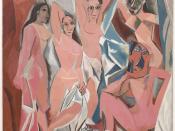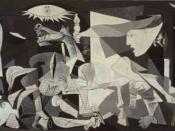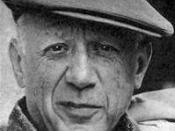Pablo Picasso is one of the twentieth century's most famous and inspirational artists. Few artists have lived as long as Picasso and none have produced the amount of work in such a variety of styles and medias as him. Much of Picasso's work is classified according to "periods" depending on what his style was at that particular period. He is known for his "Blue" period in which he expressed human misery through painting with only shades of blue. During the "Rose" period, he moved onto happier themes, in which he used shades of pink and red. He also went through a "Cubist" period and a "Neoclassical" period. Picasso produced work in painting, sculpture, prints, murals, and ceramics; regardless of the medium, he was always in demand. During the year 1937, Picasso agreed to paint the centerpiece for The Spanish Pavilion of the 1937 World's Fair. For months Picasso was searching for inspiration for the mural, distracted by his sullen mood and dissatisfaction of his work, he continued to put it off.
This came to an end on April 28, 1937. In less than two months, Picasso had created Guernica, modern arts most powerful antiwar statement.
To fully appreciate the intensity and power of Guernica, it is imperative to understand the story that precedes it. The attack on Guernica was planned on a Monday, market day in the village; most of the population would be out in town. Church bells began to ring, warning of the approaching aircraft. Germany's best-equipped bombers dumped more than one hundred thousand pounds of high explosive bombs onto the village of Guernica. People began to scurry into shelters only to find out that the shelters were not strong enough to withstand the powerful bombing that lasted three hours. Entire families were burned or buried in the...



Good paper
The paper is nicely written and has important information on Pablo Picasso.
1 out of 2 people found this comment useful.